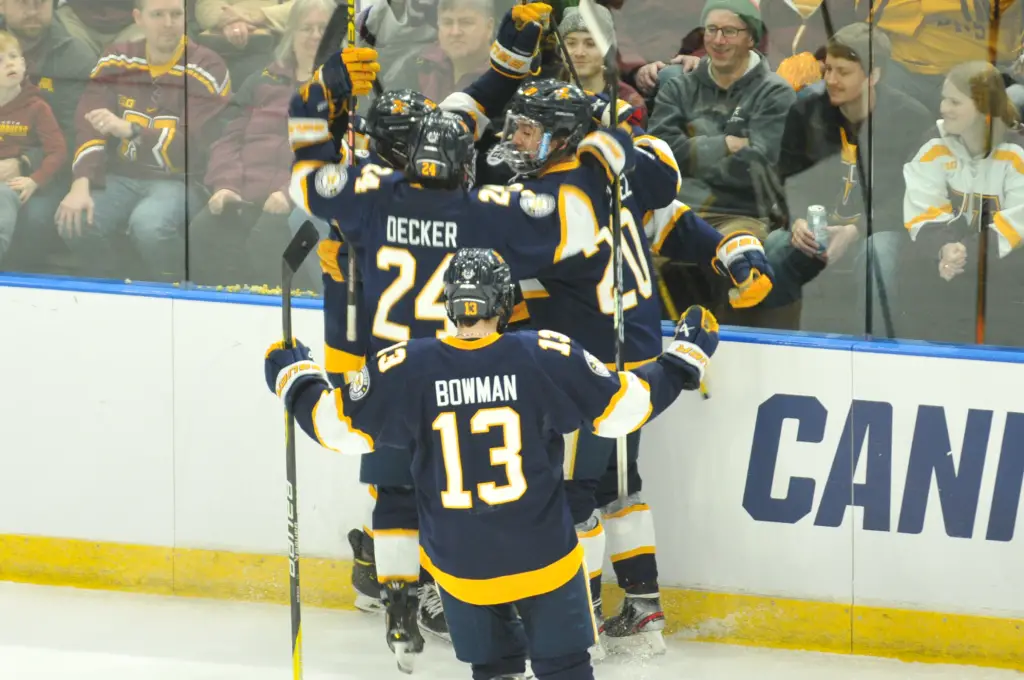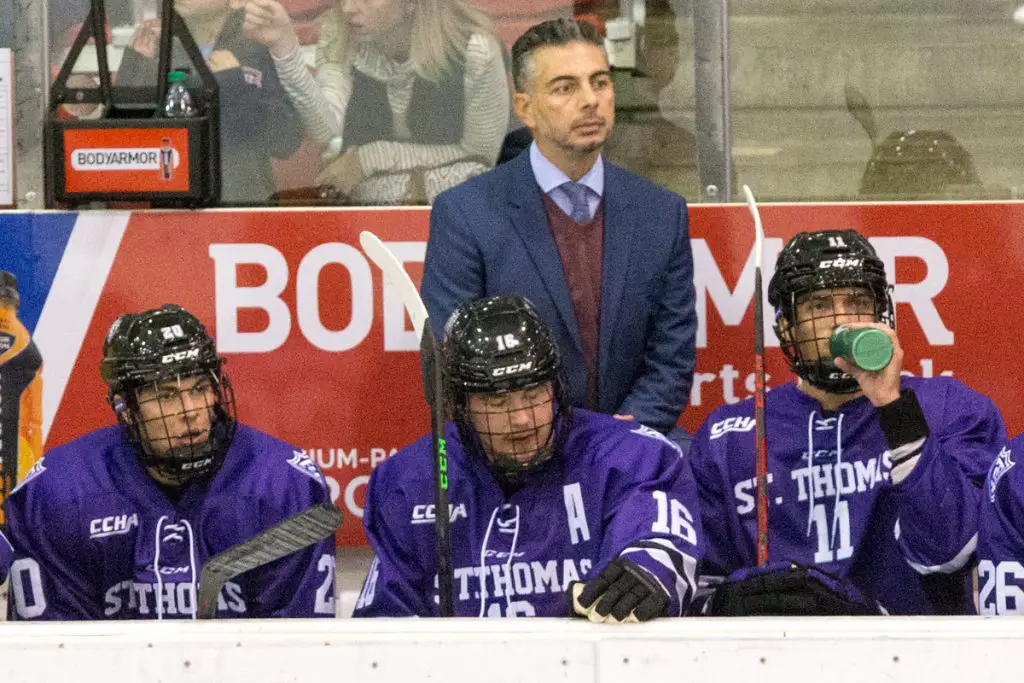
College hockey’s tides are changing.
The emergence of new programs and their alignment into new conferences are inserting new conversation pieces into the overall landscape, and the rising profiles of Arizona State and Augustana are two examples in a world that looks nothing like its historical decades. The transformation is sometimes hard to swallow, but the moving and grinding plates are part of how growth is shifting its overall profile.
No two moves are the same, but the base of the sport shares the same values on which it expects to move forward into a new era. The build is being done with a certain togetherness, but that’s why every move is well-calculated and not simply a case of team-into-league. With the Arizona State and Augustana moves in particular, the next natural question is about what happens next in college hockey now that unbalanced leagues are embracing their new structure.
“Competing with an odd number of teams, I think, was a sticking point at one point,” said NCHC commissioner Heather Weems. “But I think we’ve seen that it can work to have an odd number of teams. The good part for us is that we’re in a place where this is where we’re at. We’re absolutely comfortable, and we feel good about our pod system. We made a decision about how we’re going to do our playoff format, and all nine teams are going to play [in the postseason] during the first year. That doesn’t mean we wouldn’t consider additional teams or having another expansion, but I don’t know that there’s an urgency that it has to be filled if we don’t think we would be as successful as with our [current] odd number.”
The days of leagues needing to add teams simply to keep membership afloat no longer exist, and schools can no longer simply start hockey programs with expectations of finding membership within any of the six conferences, which is why each situation carries its own set of case-by-case requirements.
It used to be, for example, that people popularly viewed Atlantic Hockey as an exit ramp for programs either rising or falling. New teams that didn’t want to sink immediate funding into their teams could find a home in the AHA, and orphaned teams left behind by their leagues automatically defaulted to the conference in the court of popular opinion. The league itself was formed with a “cost containment” structure that protected programs in the Northeast against the rising expenses associated with Division I hockey, but things have unquestionably changed for a conference that spent the last decade growing itself through internal mechanisms.
“It’s not very difficult for anybody looking at the composition of our teams and members to see that we have public and private schools, large and small schools, and geographic differences,” said new Atlantic Hockey commissioner Michelle Morgan. “We have faith-based institutions and service academies, and we’re probably the most diverse when you talk about categories or demographics for how a school might classify or identify themselves, but at the same point, we all come together with the common thread of hockey.”
It hasn’t always been strictly about funding, but the choice to invest in Atlantic Hockey programs exploded them into the national scene in recent years. The 2014 opening of the Gene Polisseni Center helped RIT move out of its humble roots at Ritter Arena, and Bentley and Sacred Heart later replaced their small, dank rinks with glittery, shiny arenas while investment strategies helped produce American International’s four-year dynasty. Mercyhurst, Holy Cross and Air Force all hosted the Ice Breaker Tournament, and Robert Morris overcame the untimely disbanding of a program to rejoin the league this year.
Those growth initiatives are in line with places like Augustana and Arizona State, both of which invested significant cash flow into their programs’ overall infrastructure, and while it doesn’t automatically guarantee Atlantic Hockey of an at-large bid in the tournament, it also doesn’t mean the league is now an automatic home for a new program.
“We have an opportunity for growth,” Morgan emphasized. “With six members on our women’s side and 12 on our men’s side, it would be great one day to consider a 12th member for a more balanced schedule and even number to round it out, and with six member institutions for our women’s league, there’s certainly an opportunity for growth to add a few more so that we’re a little more hefty and robust in terms of membership, but we’re not going to add anybody on either gender, in either league, for the sake of adding. It has to be right for a lot of different reasons.
“It’s mutually beneficial for the institution that’s going to become a member,” she said, “but also to our conference schools and the conference as a whole. And that really boils down to strategy. I think something that’s in my initial focus for my tenure is really writing up a game plan of what’s worked well and maybe what hasn’t worked so well, along with how we’re working smarter with the resources that we do have.”

None of this locks a door on membership in any league, but understanding how leagues are changing is a critical realization. The sport is expensive, and marriages of conveniences historically led to messy divorces. The proud traditions that were once part of the WCHA and CHA no longer exist because arranged relationships didn’t survive, and building success requires a concerted effort from everyone involved.
The biggest thing we wanted to see and what’s always been important for the league’s membership is that the program is committed to our tradition of excellence,” Weems emphasized. “Obviously, Arizona State had a great tradition in their club program, but you can’t change that they’re relatively new. But they’ve demonstrated success, and they’re here to play. They’re here to play a strong schedule and compete, so while some of our programs have a strong, long tradition, once we saw Arizona State’s commitment to next-level excellence, we knew they’d fit in with us. They have a brand, in some ways, that’s probably the most notable brand of any of our schools just because of their department’s strength [as a traditional power conference team].
“College hockey in general has really evolved,” Morgan noted, “and I’ve seen it change since I’ve been in college athletics over the last 12-plus years. That’s for all sports, not just hockey, but the world of sport and the proverbial arms race for providing the student-athlete experience, they’re challenges that institutions face. Athletic departments are not immune to enrollment-driven institutions or if budgets are getting tighter, and that’s forcing a hand at times for departments to make tough decisions about what sports they sponsor.”
It’s hard to imagine a world where college hockey doesn’t change, but it’s impossible to envision what comes next. Ideas won’t stop spitballing, and there are easy, low-hanging pieces of fruit available for the teams in Alaska or at Lindenwood, Stonehill and Long Island.
The women’s programs that started the New England Women’s Hockey Alliance have enough membership to start a men’s league if the six Northeast-10 Conference teams ever decided to play-up into Division I, and both Alaska schools survived economic question marks compounded by the loss of their conference affiliation. Constant growth exists with women’s hockey and at the Division III levels, and the ongoing hunger and appetite for the game is proving that the ship is too far sailed to return hockey to its lower locales.
How new teams would survive or support the sport while enriching talent is all part of the open dialogue, but there’s no surefire path fully charting the game’s course. Hockey will change, but the manner in which it changes is up to the people living its life and breathing its breath. Future success is dictated by the combination of past and present moves, and the collaborative drive is very much a piece of writing college hockey’s story over the next decade and beyond.


